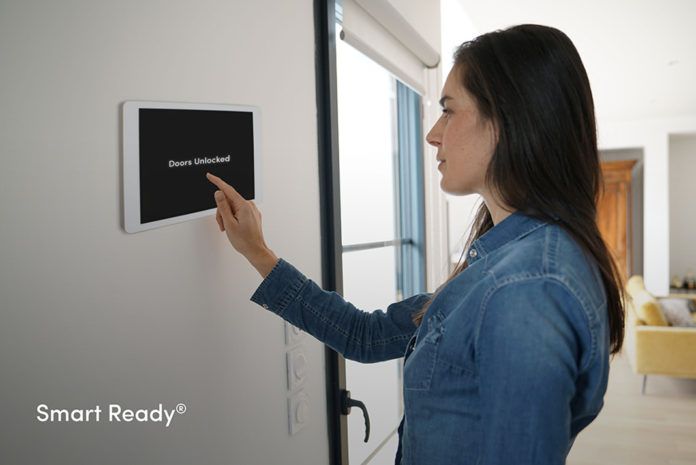
When there’s a new commercial idea or opportunity, it’s very easy to get carried away. Businesses looking to differentiate, grow sales and seize the marketing ‘attacker’s advantage’ want to be first. But there’s a danger that goes along with this, especially when that new opportunity involves the intricacies of the tech and smart markets. Not completing necessary field trials and product improvements based on working with and listening to customers, in my opinion is a cardinal sin. Believe me when I say, the work following a soft launch aimed at testing the market is one of the most onerous parts of bringing new products to market. It’s one of the reasons that after FIT last year and then broadening the reach of manufacturing and carrying out customer trials, Sac and Hug have spent recent months perfecting a solution which offers complete compliance to the new Smart Ready Standard that is designed to protect consumers and fabricators from unforeseen problems.
Collective responsibility
The dangers of going to market with a product that’s not fully formed can be catastrophic and ruin significant market opportunity for an entire industry. Not only does the original brand get damaged, but potentially also the reputation and robustness of a whole market – for example, when so-called smart doors and windows are using outdated technology, apps that can be hacked, sensors with limited connectivity or components that don’t fit properly or spoil aesthetics.
This is why the Smart Ready Standard has been introduced, to ensure consistency and technical clarity that will help every hardware design company, fabricator and installer to provide every homeowner with a smart product that’s actually fit for purpose. As a business, you need to be protected from non-specialist suppliers who are playing with new and emerging technology, but not really understanding it and using it to its full potential. We’ve seen some products that don’t even tick some real fundamental requirements of the Smart Ready Standard which has shocked me. Here are the basics:
The battle of the battery
One of the fundamental parts to smart wireless connectivity is the battery. You can only have smart features if you have the right battery capacity needed to power the right chipset for certain smart features, and the battery also needs to last, because we all know as end users, if we have to change the battery too often, we will give up. However, developing wireless smart with a long life battery is one of the most challenging technical issues to overcome. The minimum requirement for a battery in wireless smart products should be no lower than 1000 mAh. Aesthetics need to be considered too. These long life batteries need to be small enough to fit into sleek units and work within standard window and door profiles without disrupting the manufacturing or installation processes too much.
Smart connections
The next challenge is the range of wireless connection. A lot of current smart product hubs are found directly plugged into the router or sit close by the router for best connection results. Smart products for windows and doors are hugely different because all windows and doors don’t sit next to the router – they are spread all over the house, often over multiple floors, and doors are at opposite ends of the house – so the wireless connection signal from window or door sensors will need to be sent over significant distances through walls and floors to reach the system’s operating hub. So special attention needs to be focused around this area, especially for aluminium windows and doors.
Hug Technology is a certified Smart Ready technology partner that has resolved this issue with new, clever sensors and repeatable system hubs that simply plug into any power socket around the home and are able to inter communicate with each other to maintain a great wireless connectivity throughout the home, and back to the home internet router.
Prevention is better than cure
It goes without saying that security is a super important feature of windows and doors, and smart solutions should enhance this. Talking to business leaders and surveying consumers, one of the key areas of demand is an alarm. In addition to a simple alarm, one of the key features of the Smart Ready certified system developed by Sac and Hug is an early warning alarm feature that lets homeowners know when a window or door experiences any level of tampering, alerting homeowners before an intruder actually enters the property. If the user is at home, this could prevent the burglary altogether. And if they’re not, the system can send a live text message or call a neighbour to ask them to check everything is OK.
Ask yourself, is it smart?
Brands often say their solution is smart, but very few challenge the validity of the claim. A key priority of smart hardware is that it has to be fit for purpose. It terrifies me to think of how easily homeowners using some monitoring sensors I’ve seen, could be led to think – by looking at the app – that their door is secure and locked, when in fact it may be locked, but also wide open. Sensors like these will cause more harm than good, and this is why the industry needs to look for a Smart Ready certified system.
Keeping it simple
By making Smart Ready doors and windows ‘clever but simple’, everyone gets a stress-free, useful and appealing solution. Set-up needs to be fast in the home – no more than 15 seconds per sensor – any changes to fabrication and installation must be straight-forward with minimum disruption and ultimately, the consumer needs to get what they want and what they’re expecting to get. After all, they probably only replace their doors and windows once every 10 years, so it’s a high value, important decision they need to get right. That’s why as an industry, we need to get it right too – even if it means it taking a little longer. Any negative result with your customer, needs to be avoided at all costs.



